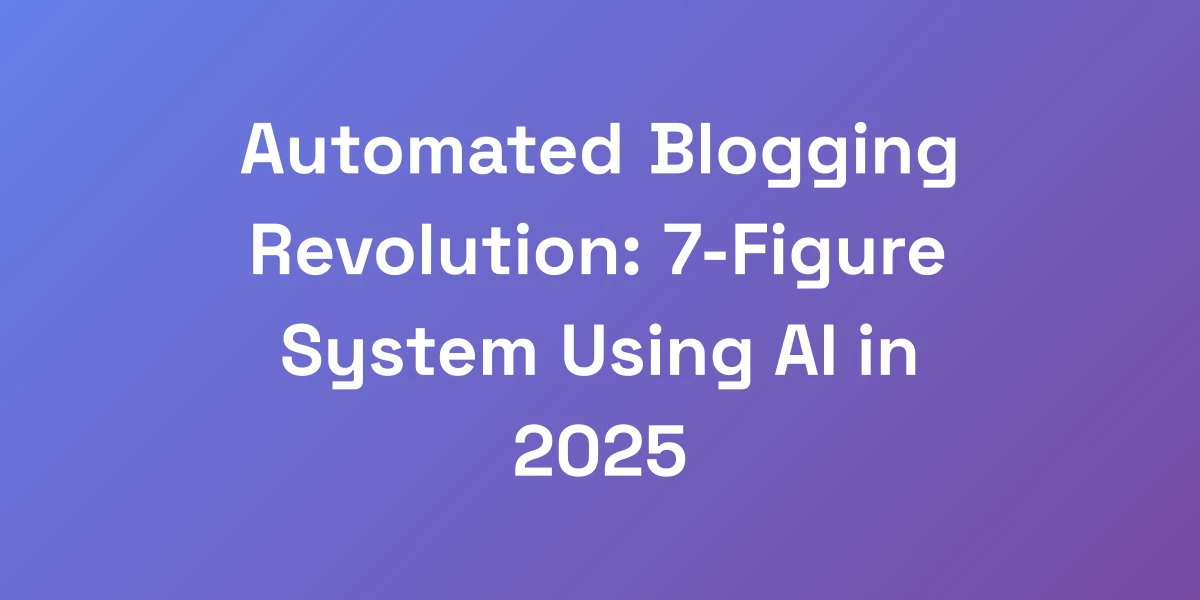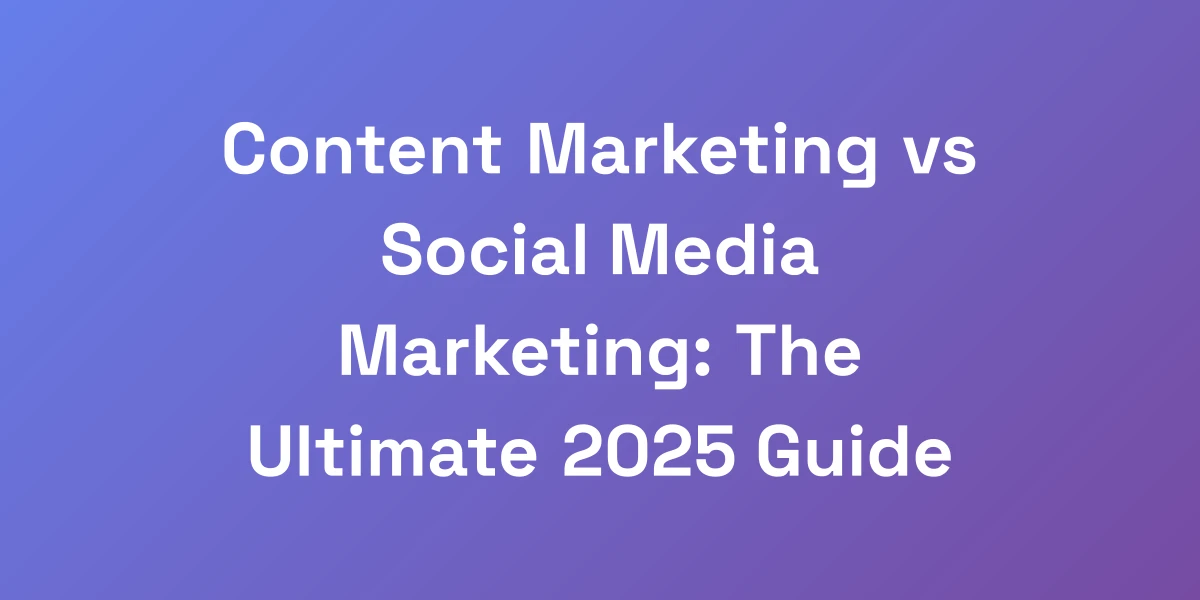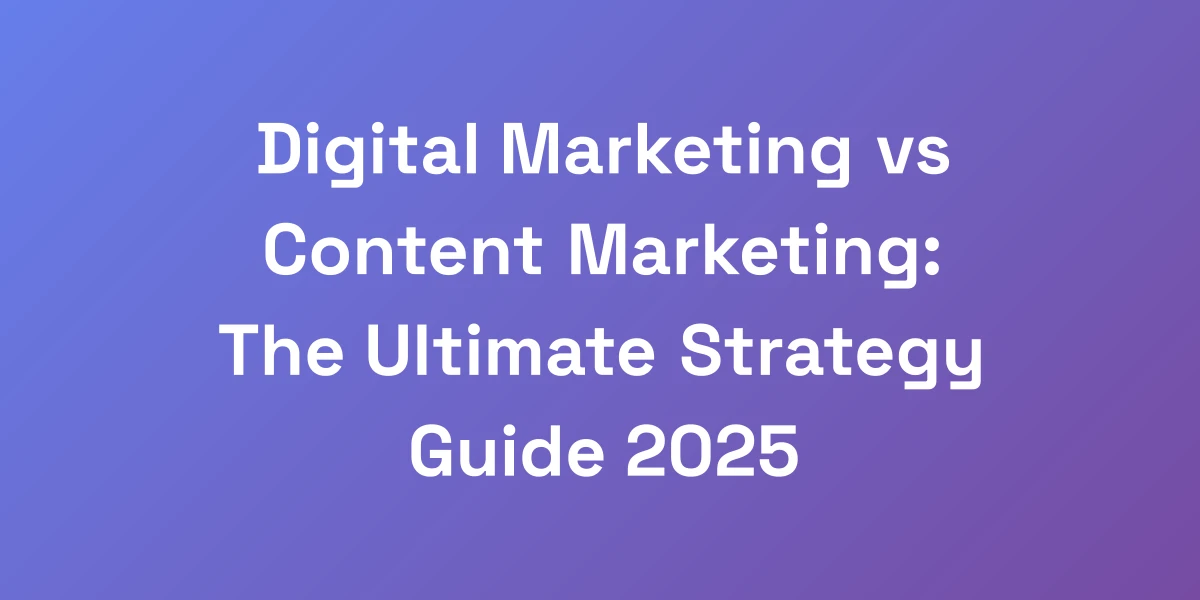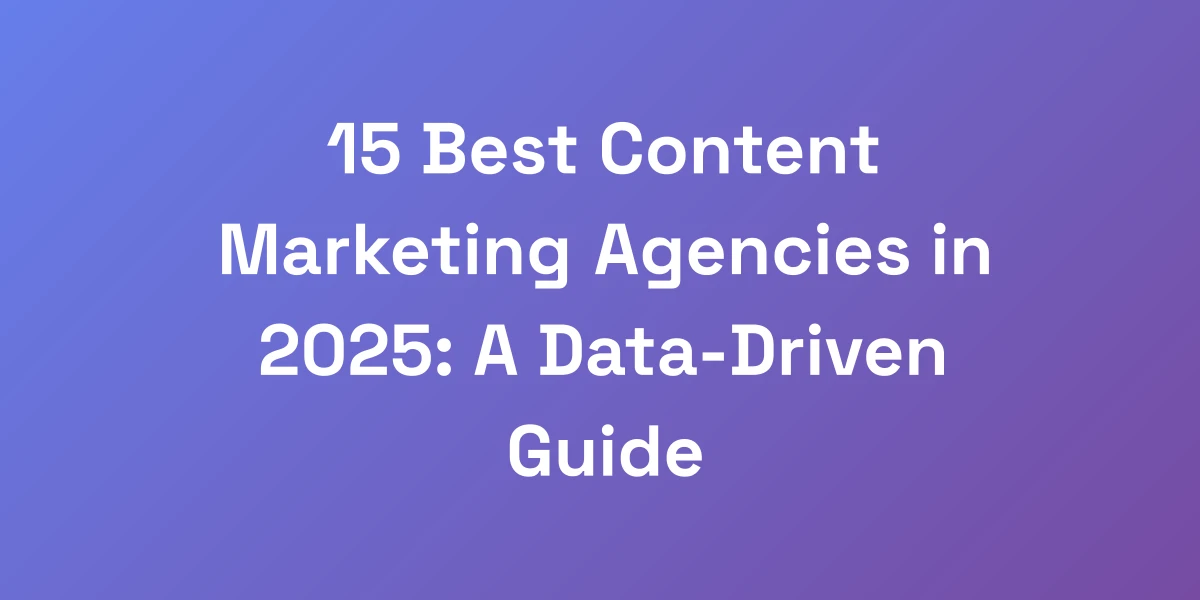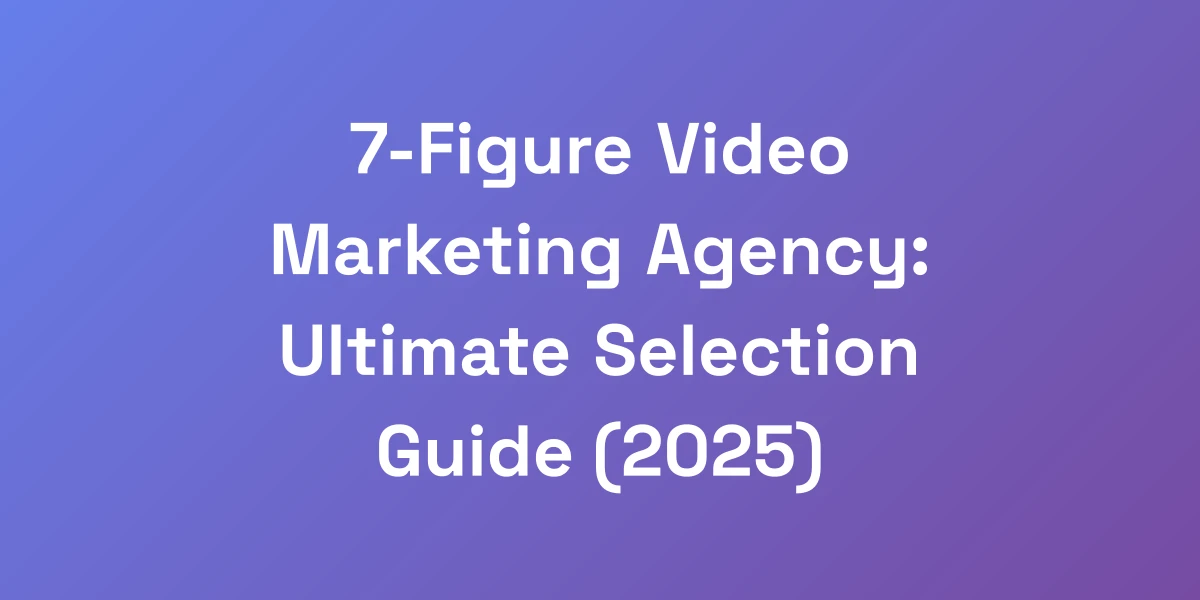
Automated Content Marketing: 7-Figure System Revealed (2025 Guide)
Mar 21, 2025 | By [email protected]
The Million-Dollar Shift: Why Content Marketing Automation Is Your Secret Weapon
Let me cut through the BS right now – if you’re still manually grinding out your content marketing, you’re leaving serious money on the table.
We’ve built multiple 8-figure businesses, and we’ll tell you straight: automation isn’t just a fancy buzzword – it’s the difference between scaling to 7-figures and staying stuck in the content hamster wheel.
The real game isn’t about working harder; it’s about building systems that multiply your output while you sleep.
In this guide, we’re going to show you exactly how to turn your content marketing into a revenue-generating machine that runs on autopilot.
The Real Cost of Manual Content Marketing
Manual content marketing might seem cost-effective at first glance. However, the hidden costs quickly add up.
Time is your most valuable asset. By manually creating, scheduling, and distributing content, you’re investing hours that could be spent on strategic growth initiatives.
Consider the opportunity cost – every hour spent on routine tasks is an hour not spent on market research or product development.
Furthermore, manual processes are prone to errors and inconsistencies, which can damage your brand’s credibility.
- Time Inefficiency: Spending excessive hours on content creation.
- Human Error: Increased risk of mistakes that can harm your reputation.
- Scalability Issues: Struggling to keep up with content demands as your business grows.
Ultimately, the real cost of manual content marketing is the missed revenue and stalled growth your business experiences.
Automation ROI: Breaking Down the Numbers
Let’s talk numbers. For every dollar spent on content marketing automation, businesses see an average ROI of $5.44 over the first three years.
That’s not just good; it’s phenomenal. Imagine reallocating your resources from tedious manual tasks to strategic endeavors that drive revenue and growth.
Here’s a simple breakdown:
- Initial Investment: Costs associated with setting up automation tools and systems.
- Operational Savings: Reduced time and labor costs due to automated processes.
- Revenue Growth: Increased content output leads to higher engagement, conversions, and ultimately, revenue.
By automating your content marketing, you’re not just saving money – you’re actively investing in a system that fuels your business’s financial growth.
With statistics showing that 70% of businesses achieve a positive ROI from content marketing, enhancing this with automation can exponentially increase those returns.
Why 83% of Marketers Fail at Automation
Despite the proven benefits, a staggering 83% of marketers fail at content marketing automation. Why?
Most fail because they approach automation the wrong way – as a set-it-and-forget-it solution.
They neglect the critical steps of strategic planning, customization, and continuous optimization necessary for success.
Without a clear strategy, even the best tools can’t compensate for poor execution.
- Lack of Strategy: Jumping into automation without a clear plan.
- Inadequate Training: Teams aren’t properly trained to use automation tools effectively.
- Failure to Integrate: Automation tools aren’t seamlessly integrated with existing systems.
To avoid being part of this statistic, it’s essential to approach automation with a well-thought-out strategy and continuous optimization efforts.
The Psychological Shift: From Creator to Strategist
Automation demands a shift in mindset – from being a content creator to becoming a content strategist.
Instead of spending time on every piece of content, you focus on the overarching strategy that drives your business goals.
This transformation allows you to:
- Think Big: Develop long-term content strategies that align with business objectives.
- Optimize Processes: Streamline workflows to maximize efficiency.
- Leverage Data: Use analytics to make informed decisions and refine your strategies.
By adopting this strategic mindset, you harness the true power of automated content marketing to drive significant growth.
Case Study: How We Generated $2.1M with Automated Content
Let’s dive into a real-world example. We implemented an automated content marketing system that generated $2.1M in revenue within a year.
Here’s how we did it:
- Content Multiplication: Turned one blog post into 30 high-converting assets.
- AI-Powered Tools: Leveraged top SEO automation tools to streamline content creation and distribution.
- Data-Driven Strategies: Continuously optimized content based on performance metrics.
By automating these processes, we not only increased our content output but also improved the quality and relevance of our content, leading to higher engagement and conversion rates.
This case study is a testament to the transformative power of content marketing automation when executed correctly.
Building Your Content Automation Engine: The Core Framework
Here’s the truth about content automation that nobody tells you: it’s not about replacing human creativity – it’s about amplifying it.
We’ve spent millions testing different systems, and we’ve distilled it down to a framework that literally prints money.
The key is building what we call the “Content Multiplication System” – a framework that takes one piece of content and turns it into 30 pieces of high-converting assets.
This isn’t theory; this is the exact system we use to generate multiple seven figures across our businesses.
The Content Multiplication System Explained
The Content Multiplication System is designed to maximize the value of each piece of content you create.
Here’s how it works:
- Primary Content Creation: Start with a high-quality, in-depth piece of content like a blog post or video.
- Content Repurposing: Break down the primary content into smaller, targeted pieces such as social media posts, infographics, and email newsletters.
- Distribution Channels: Automate the distribution across various platforms to ensure consistent reach and engagement.
- Performance Tracking: Use analytics to monitor the performance of each piece and adjust strategies accordingly.
This system ensures that your content is consistently reaching and engaging your target audience, driving sustained revenue growth.
Essential Tech Stack for 10X Output
To build an efficient content automation engine, having the right tools is crucial. Here’s our essential tech stack:
- AI Content Generators: Tools like AI content generators like Jasper AI and Writesonic for creating high-quality content quickly.
- Content Management Systems (CMS): Platforms like WordPress or HubSpot to organize and manage your content.
- Automation Platforms: Systems like Zapier or Integromat for integrating different tools and automating workflows.
- Analytics Tools: Google Analytics and SEMrush for tracking content performance.
- Social Media Schedulers: Tools like Buffer or Hootsuite to automate social media posts.
By leveraging these tools, you can significantly increase your content output without sacrificing quality.
Setting Up Your Automation Workflows
Setting up effective automation workflows is the backbone of automated content marketing.
Here’s a step-by-step guide:
- Identify Repetitive Tasks: Pinpoint tasks that are time-consuming and repetitive, such as content scheduling or email marketing.
- Choose the Right Tools: Select automation tools that integrate seamlessly with your existing tech stack.
- Map Out the Workflow: Design a workflow that automates the identified tasks, ensuring each step is clearly defined.
- Implement and Test: Set up the automated workflows and run tests to ensure everything operates smoothly.
- Optimize Continuously: Regularly review and tweak your workflows based on performance data.
By following these steps, you can streamline your content marketing processes, saving time and increasing efficiency.
Content Distribution Automation Blueprint
Effective distribution is as important as content creation. Here’s our blueprint for automating content distribution:
- Multi-Channel Strategy: Distribute content across multiple platforms such as social media, email, and your website.
- Automated Scheduling: Use tools like Buffer or Hootsuite to schedule posts at optimal times.
- Personalized Distribution: Tailor content distribution based on audience segments for higher engagement.
- Content Tracking: Implement tracking mechanisms to monitor distribution performance across channels.
- Feedback Loops: Use automated feedback systems to gather insights and refine distribution strategies.
This blueprint ensures that your content reaches the right audience at the right time, maximizing its impact and driving conversions.
Quality Control Gates in Automated Systems
Automation should enhance, not compromise, content quality. Implementing quality control gates is essential.
Here’s how to ensure quality within your automated systems:
- Content Review Processes: Set up stages where content is reviewed by editors before publication.
- Automated Quality Checks: Use tools that scan for grammatical errors and maintain consistency in style.
- Feedback Mechanisms: Incorporate feedback loops where performance data is used to enhance content quality.
- Consistency Standards: Establish guidelines that all automated content must adhere to, ensuring uniformity.
- Regular Audits: Conduct periodic audits of your automated content to ensure it meets your quality standards.
By instituting these quality control measures, you ensure that automation serves as a tool for maintaining high standards rather than diminishing them.
Advanced AI Tools That Are Actually Worth Your Money
Listen, we’ve wasted hundreds of thousands on shiny tools that promised the world but delivered nothing. Today, we’re going to save you that pain.
The right AI tools can 10x your content production, but the wrong ones will drain your bank account.
We’ll share the exact stack we use to generate over 500 pieces of content monthly with just two team members.
These aren’t just tools; they’re profit multipliers when used with the right strategy.
Top 5 AI Content Generation Tools (With ROI Data)
Choosing the right AI content generation tool is crucial for maximizing ROI. Here are our top five picks:
- Jasper AI: Starts at $49/month and offers templates for blog posts, emails, and social media content. With its ability to learn from user input, Jasper AI significantly boosts content quality and relevance.
- Writesonic: Offers a free plan and a $20/month individual plan. It’s perfect for small content creators needing efficient article generation.
- Content at Scale: Starting at $250/month for eight articles, this tool uses three AI engines to focus on SEO, providing key takeaways and “People Also Ask” sections, ideal for large organizations.
- Frase: At $14.99/month, Frase combines AI content creation with SEO optimization, suggesting topics and generating outlines, perfect for marketers looking to improve search engine rankings.
- Rytr: A budget-friendly option at $9/month for premium plans, supporting multiple languages and tones, suitable for freelancers and small businesses.
These tools have proven ROI, reducing content creation time by up to 70% and increasing output without compromising quality.
Content Planning and Strategy Tools
A solid content plan is the backbone of successful automation. Here are essential tools for planning and strategy:
- Trello: Organize your content calendar and workflows with its intuitive board and card system.
- Asana: Manage projects and track progress with advanced task management features.
- Monday.com: Enhance collaboration with customizable workflows and integration capabilities.
These tools help streamline the planning process, ensuring that your content strategy is aligned with your business goals.
Analytics and Performance Tracking Systems
Understanding the performance of your automated content is essential for optimization. Here are top analytics tools:
- Google Analytics: Track website traffic, user behavior, and conversion rates to measure content effectiveness.
- SEMrush: Analyze SEO performance, keyword rankings, and competitor strategies.
- Hotjar: Gain insights into user interactions with heatmaps and session recordings.
These systems provide the data you need to refine your content strategies and maximize ROI.
Automation Integration Platforms
Integrating your tools is key to a seamless automation workflow. Here are our top integration platforms:
- Zapier: Connect over 2,000 apps to automate workflows without coding.
- Integromat: Create complex integrations with visual builders for advanced automation needs.
- IFTTT: Automate simple tasks with its user-friendly interface, perfect for small-scale operations.
These platforms ensure that your tools work together harmoniously, enhancing efficiency and productivity.
Hidden Gems: Underrated Tools That Outperform
While the top tools get most of the attention, some underrated tools can offer exceptional performance:
- Clearscope: Enhances SEO content with detailed keyword analysis and optimization tips.
- SurferSEO: Combines content creation with on-page SEO analysis for better search rankings.
- Grammarly Business: Ensures impeccable grammar and style consistency across all content.
These hidden gems can provide significant value, often outperforming more popular tools in specific tasks.
Investing in the right AI tools tailored to your needs can transform your automated content marketing efforts, driving substantial growth and revenue.
The 72-Hour Content Automation Implementation Plan
Most people overcomplicate automation and never get started. Here’s the brutal truth: you can set up 80% of your content automation system in just 72 hours.
We’re going to give you the exact hour-by-hour blueprint we use with our consulting clients who pay us $10,000+ for this information.
This is about implementation, not theory – by the end of this section, you’ll have a working system.
Day 1: Foundation and Tool Setup
Starting with the foundation is crucial. Here’s what to tackle on Day 1:
- Define Objectives: Clearly outline what you aim to achieve with automation.
- Choose the Right Tools: Select automation tools that integrate seamlessly with your existing tech stack.
- Set Up Accounts: Register and configure all necessary tools, ensuring they’re ready for integration.
- Create Templates: Develop content templates to maintain consistency across your automated content.
By the end of Day 1, you’ll have a solid foundation and all necessary tools in place.
Day 2: Workflow Creation and Integration
Day 2 is all about building and integrating your workflows:
- Map Out Workflows: Define each step of your content creation and distribution process.
- Integrate Tools: Use platforms like Zapier to connect your selected tools, ensuring seamless data flow.
- Automate Tasks: Set up automation for content scheduling, social media posting, and email distribution.
- Test Integrations: Ensure all tools are communicating correctly and workflows operate smoothly.
- Optimize Continuously: Regularly review and tweak your workflows based on performance data to ensure maximum efficiency.
By the end of Day 2, your primary workflows should be operational, automating key content marketing tasks.
Day 3: Testing and Optimization
On Day 3, focus on testing and refining your system:
- Run Tests: Execute sample workflows to identify any issues or bottlenecks.
- Gather Feedback: Collect input from your team and make necessary adjustments.
- Optimize Processes: Fine-tune automation steps based on test results to ensure maximum efficiency.
- Implement Quality Controls: Set up automated checks to maintain content quality.
By the end of Day 3, your content automation system should be fully functional and optimized for performance.
Common Implementation Pitfalls
Implementing automation isn’t without challenges. Here are common pitfalls and how to avoid them:
- Lack of Clear Objectives: Ensure your goals are well-defined from the start.
- Overcomplicating Workflows: Keep your automation processes simple and manageable.
- Neglecting Training: Provide adequate training for your team to ensure effective tool usage.
- Ignoring Data: Use analytics to continuously refine and improve your automation system.
Avoiding these pitfalls will help you implement a smooth and effective automated content marketing system.
Scaling Your System Beyond Day 3
Once your initial system is up and running, it’s time to scale:
- Expand Content Types: Incorporate different types of content like videos, podcasts, and webinars.
- Increase Output: Gradually increase the volume of content while maintaining quality.
- Integrate Advanced Tools: Incorporate more sophisticated AI tools like advanced AI tools for enhanced content creation and analysis.
- Automate More Processes: Identify additional tasks that can be automated to further improve efficiency.
Scaling ensures that your content marketing automation system grows with your business, continuously driving higher revenue and engagement.
Measuring Success: The Only Metrics That Actually Matter
Stop wasting time on vanity metrics that don’t move the needle. In our businesses, we focus on just three key metrics that directly correlate with revenue.
These metrics have helped us scale multiple businesses past 7-figures using automated content.
We’re going to show you exactly how to track these numbers and, more importantly, how to adjust your automation system based on the data.
The Three Revenue-Driving Metrics
Focusing on the success metrics of your automated content marketing efforts.
- Conversion Rate: The percentage of visitors who take a desired action, such as making a purchase or signing up for a newsletter.
- Customer Acquisition Cost (CAC): The total cost of acquiring a new customer, including marketing and sales expenses.
- Customer Lifetime Value (CLV): The total revenue a business can expect from a single customer account throughout its relationship.
These metrics provide a clear picture of how your content marketing automation is driving revenue and growth.
Setting Up Automated Tracking Systems
To accurately track these metrics, you need robust automated tracking systems:
- Google Analytics: Set up conversion tracking and goal funnels to monitor conversion rates.
- CRM Integration: Integrate your content automation tools with CRM systems like HubSpot or Salesforce to track CAC and CLV.
- Automated Dashboards: Use tools like Google Data Studio or Tableau to create real-time dashboards that display your key metrics.
Automated tracking ensures you have up-to-date data to make informed decisions about your content marketing strategies.
Real-Time Performance Dashboards
Real-time dashboards are essential for monitoring the performance of your automated content marketing efforts:
- Custom Dashboards: Tailor your dashboards to display the most relevant metrics for your business.
- Automated Reports: Schedule regular automated reports to keep track of progress without manual intervention.
- Visual Analytics: Use visual representations like charts and graphs for easy interpretation of data.
These dashboards provide a clear, instant view of how your content is performing, allowing for quick adjustments and optimizations.
ROI Calculation Framework
Calculating ROI is vital to understanding the financial impact of your automated content marketing system:
- Determine Total Costs: Include all expenses related to content creation, tool subscriptions, and implementation.
- Measure Revenue Generated: Track all revenue attributed to your content marketing efforts.
- Calculate ROI: Use the formula (Revenue – Cost) / Cost to determine your ROI.
This framework helps you evaluate whether your investment in content automation is paying off and guides future budget allocations.
Monthly Optimization Protocol
Continuous optimization is key to sustaining and growing your automated content marketing efforts:
- Review Metrics: Analyze your key metrics monthly to identify trends and areas for improvement.
- A/B Testing: Conduct A/B tests on different content strategies to determine what works best.
- Adjust Workflows: Refine your automation workflows based on performance data to enhance efficiency.
- Update Tools: Stay updated with the latest features and updates of your automation tools to maximize their potential.
By adhering to a monthly optimization protocol, you ensure that your content marketing automation system remains effective and continues to drive growth.
Conclusion
We’ve walked you through a comprehensive guide on building a 7-figure automated content marketing system.
From understanding the immense benefits of automation to setting up a robust framework and selecting the right AI tools, every step is designed to scale your business efficiently.
The key takeaways are clear: automation amplifies your content efforts, frees up valuable time, and drives significant revenue growth.
Now, it’s your turn to implement these strategies and transform your content marketing into a relentless revenue machine.
Ready to take your content marketing to the next level? Start setting up your automated system today and watch your business soar.
Have questions or need further guidance? Drop a comment below or reach out to share your experiences with automated content marketing. Let’s grow together!
